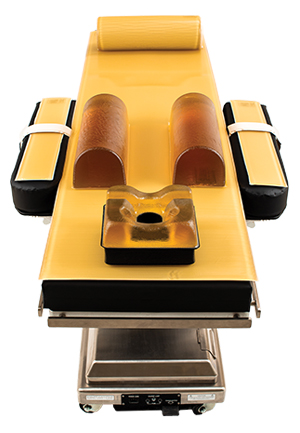
One of the biggest responsibilities of the operating room (OR) team is to ensure patient safety. There are many facets to patient safety in the OR. Safe patient positioning is a critical facet since the patient is unable to tell you if they are in pain or uncomfortable. The first step to improved outcomes related to patient positioning is to look to the evidence for guidance when choosing your positioning device. There are extrinsic and intrinsic factors that contribute to the development of pressure injuries (PI) in the OR; one of the extrinsic factors is prolonged surface interface pressure. In this week’s blog we will look at a scientific comparison between foam and gel used as positioning devices in order to determine best practice.
Pressure redistribution is key to decrease pressure injuries in the OR and unfortunately foam devices produce only a minimum amount of pressure redistribution and often allow the patient to “bottom out” as Macky (2006) explains. Bottoming out occurs when the support surface becomes fully compressed under the weight of the patient’s body, resulting in the patient lying directly on a hard surface.
Sutton, Link, and Makic (2013) found that additional padding with convoluted foam (e.g., egg crate) padding did not reduce the pressure; however, gel (i.e., viscoelastic polymer) padding provided better protection from excessive pressure.
McNichol, Watts, Mackey, Beitz and Gray (2015) tell us, “There is a lack of evidence that exists regarding the optimal foam density and indentation load deflection for preventing pressure injury in perioperative patients.” That is scary since we cannot gauge which patient benefits from foam and which patient does not.
AORN reports in the 2022 Guideline for Positioning the Patient (7.5) that static surfaces such as viscoelastic polymer (i.e., gel) overlays are designed to reduce shearing and to support the patient’s weight without becoming fully compressed under the weight of the patient’s body. Gel overlays and positioning devices are radiolucent, latex-free, and reusable. Thus, among other benefits, gel is a good solution to the “bottom out” effect that causes undue pressure and sheer.
After looking at the literature and the latest AORN guidelines, it is easy to see that gel positioning devices can create better outcomes for your patients. When a change in practice is needed, look to the evidence and let that be your guide.
References:
Mackey D. Support surfaces: beds, mattresses, overlays—oh my! Nurs Clin North Am. 2005;40(2):251–265. [VB]. Retrieved from: https://www.ncbi.nlm.nih.gov/pubmed/15924893 May 18, 2020
Sutton, Shauna, Terri Link, and Mary B. F. Makic. "A Quality Improvement Project for Safe and Effective Patient Positioning during Robot-Assisted Surgery: The Official Voice of Perioperative Nursing the Official Voice of Perioperative Nursing." AORN Journal, vol. 97, no. 4, 2013, pp. 448-56. Retrieved from: https://www.ncbi.nlm.nih.gov/pubmed/23531311 May 18, 2020
McNichol L, Watts C, Mackey D, Beitz JM, Gray M. Identifying the right surface for the right patient at the right time: generation and content validation of an algorithm for support surface selection. J Wound Ostomy Continence Nurs. 2015;42(1):19–37. [IVA]. Retrieved from: https://www.ncbi.nlm.nih.gov/pubmed/25549306 May 18, 2020
Armstrong D, Bortz P. An integrative review of pressure relief in surgical patients. AORN J. 2001;73(3):645–653. [VB]. Retrieved from: https://www.ncbi.nlm.nih.gov/pubmed/11253620 May 18, 2020
Engels D, Austin M, McNichol L, Fencl J, Gupta S, Kazi H. Pressure ulcers: factors contributing to their development in the OR. AORN J. 2016;103(3):271–281. [VA]. Retrieved from: https://www.ncbi.nlm.nih.gov/pubmed/26924365 May 18, 2020
Pressure Ulcer Prevention in the O.R.: Recommendations and Guidance. St Paul, MN: Minnesota Hospital Association; 2013. https://www.mnhospitals.org/Portals/0/Documents/ptsafety/skin/OR-pressure-ulcer-recommendations.pdf Accessed May 18, 2020. [IVC]
B9003-000

